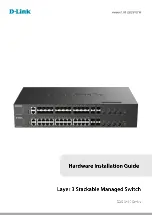
Appendix A
Acronyms
135
IPMC Profile
IPMC Profile is an acronym for IP MultiCast Profile. IPMC Profile is used to deploy the access control on IP multicast
streams.
IP Source Guard
IP Source Guard is a secure feature used to restrict IP traffic on DHCP snooping untrusted ports by filtering traffic
based on the DHCP Snooping Table or manually configured IP Source Bindings. It helps prevent IP spoofing attacks
when a host tries to spoof and use the IP address of another host.
LACP
LACP is an IEEE 802.3ad standard protocol. The Link Aggregation Control Protocol, allows bundling several physical
ports together to form a single logical port.
LLC
The IEEE 802.2 Logical Link Control (LLC) protocol provides a link mechanism for upper layer protocols. It is the
upper sub-layer of the Data Link Layer and provides multiplexing mechanisms that make it possible for several
network protocols (IP, IPX) to coexist within a multipoint network. LLC header consists of 1 byte DSAP (Destination
Service Access Point), 1 byte SSAP (Source Service Access Point), 1 or 2 bytes Control field followed by LLC information.
LLDP
LLDP is an IEEE 802.1ab standard protocol. The Link Layer Discovery Protocol(LLDP) specified in this standard allows
stations attached to an IEEE 802 LAN to advertise, to other stations attached to the same IEEE 802 LAN, the major
capabilities provided by the system incorporating that station, the management address or addresses of the entity or
entities that provide management of those capabilities, and the identification of the stations point of attachment to
the IEEE 802 LAN required by those management entity or entities. The information distributed via this protocol is
stored by its recipients in a standard Management Information Base (MIB), making it possible for the information to
be accessed by a Network Management System (NMS) using a management protocol such as the Simple Network
Management Protocol (SNMP).
LLDP-MED
LLDP-MED is an extension of IEEE 802.1ab and is defined by the telecommunication industry association (TIA-1057).
LLQI
LLQI (Last Listener Query Interval) is the maximum response time used to calculate the Maximum Response Code
inserted into Specific Queries. It is used to detect the departure of the last listener for a multicast address or source. In
IGMP, this term is called LMQI (Last Member Query Interval).
LOC
LOC is an acronym for Loss Of Connectivity and is detected by a MEP and is indicating lost connectivity in the
network. Can be used as a switch criteria by EPS
MAC Table
Switching of frames is based upon the DMAC address contained in the frame. The switch builds up a table that maps
MAC addresses to switch ports for knowing which ports the frames should go to ( based upon the DMAC address in
the frame ). This table contains both static and dynamic entries. The static entries are configured by the network
administrator if the administrator wants to do a fixed mapping between the DMAC address and switch ports.
The frames also contain a MAC address ( SMAC address ), which shows the MAC address of the equipment sending
the frame. The SMAC address is used by the switch to automatically update the MAC table with these dynamic MAC
addresses. Dynamic entries are removed from the MAC table if no frame with the corresponding SMAC address have
been seen after a configurable age time.
MEP
MEP is an acronym for Maintenance Entity Endpoint and is an endpoint in a Maintenance Entity Group (ITU-T
Y.1731).
MD5
MD5 is an acronym for Message-Digest algorithm 5. MD5 is a message digest algorithm, used cryptographic hash
function with a 128-bit hash value. It was designed by Ron Rivest in 1991. MD5 is officially defined in RFC 1321 - The
MD5 Message-Digest Algorithm.
Summary of Contents for GSW-3208M2
Page 1: ...1 GSW 3208M2 Managed Gigabit Ethernet Switch ...
Page 145: ......











































